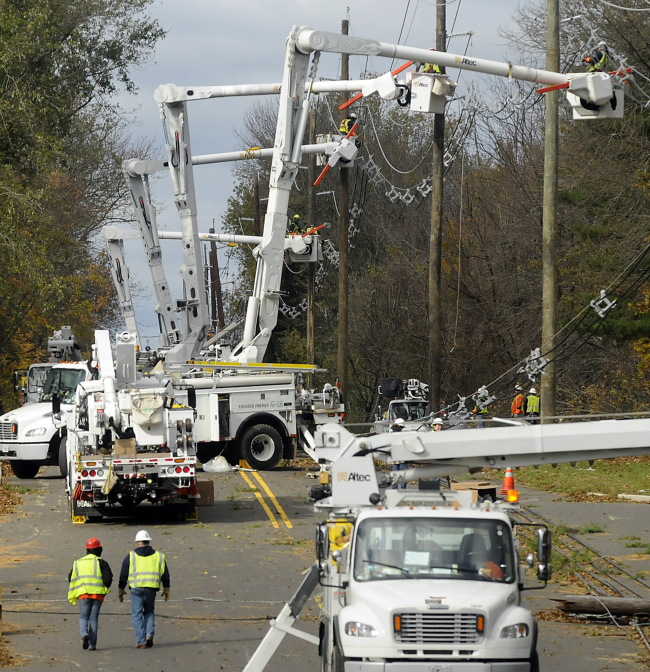NEW YORK (AP) ― More New Yorkers got power Saturday for the first time since Superstorm Sandy struck the region, but frustrations mounted over gasoline shortages as refueling sites turned into traffic jams of horn-honking confusion.
Gas rationing went into effect in northern New Jersey, while crowds lined up at free fuel distribution sites in New York’s boroughs, where a limit of 10 gallons per person was imposed. New York officials then said emergency vehicles had the priority over the public.
“It’s chaos, pandemonium out here,” said Chris Damon, whose family was displaced from his home in the Queens neighborhood of Far Rockaway and are staying with relatives in Brooklyn. He circled the block for 3 1/2 hours at the Brooklyn Armory, where the National Guard was directing traffic.
“It’s ridiculous. No one knows what’s going on,” he said.
New York Gov. Andrew Cuomo had announced that the 5,000-gallon trucks from the Defense Department would set up the emergency mobile gas stations at five locations around the New York City metropolitan area.
“Do not panic. I know there is anxiety about fuel,” he said.
After the long lines formed, New York state officials said the public should stay away from the refueling stations until emergency responders first got their gas and more supplies are then made available.
 |
Utility crews restore power lines in Hopewell Township, New Jersey, Saturday. (AP-Yonhap News) |
The scene was more orderly in hard-hit Staten Island, where a line of cars stretched for two miles under the supervision of police and National Guard troops. Another 400 people were on foot, carrying gas cans.
As gas rationing went into effect at noon in northern New Jersey, police began enforcing rules to allow only motorists with odd-numbered license plates to refuel. Those with even-numbered plates must wait until Sunday.
Jessica Tisdale of Totowa waited in her Mercedes SUV for 40 minutes at a gas station in Jersey City, but didn’t quite understand the rules and was ordered to pull away because of her even-numbered plate.
“Is it the number or the letter?” she asked around 12:10 p.m. “I don’t think it’s fair. I’ve been in the line since before noon. I don’t think it’s fair. There’s no clarity.”
The officer who waved her out of line threw up his hands and shrugged.
At an Exxon station in Wall, New Jersey, Kathryn Davidson was unaware of the start of rationing but beat the noon deadline despite a 45-minute wait in line and an even-numbered plate.
“How are people supposed to know?” said Davidson, 53, who said it reminded her of the 1970s, when a similar plan was in place.
“There were fistfights and everything. It got nasty,” she said. “Everyone seems pretty pleasant as of right now.”
In Washington, President Barack Obama visited the headquarters of the Federal Emergency Management Agency for an update on superstorm recovery efforts and said “there’s nothing more important than us getting this right.”
“Obviously we’ve now seen that after the initial search and rescue, the recovery process is difficult and it’s painful,” Obama said. “But I’m confident that we will continue to make progress as long as state and local and federal officials stay focused.”
Obama cited the need to restore power; pump out water, particularly from electric substations; ensure that basic needs are addressed; remove debris; and get federal resources in place to help transportation systems come back on line.
About 2.6 million people remained without power in six states after Sandy came ashore Monday night.
About 900,000 people still didn’t have electricity in the New York metropolitan area, including about 550,000 on Long Island, Cuomo said.
About 80 percent of New York City’s subway service has been restored, he added.
The storm forced cancellation of Sunday’s New York City Marathon. Mayor Michael Bloomberg reversed himself Friday and yielded to mounting criticism about running the race, which starts on hard-hit Staten Island and wends through all five of the city’s boroughs.
Bloomberg, who as late as Friday afternoon insisted the world’s largest marathon should go on as scheduled, changed course shortly afterward amid intensifying opposition from the city comptroller, the Manhattan borough president and sanitation workers unhappy they had volunteered to help storm victims but were assigned to the race instead. The mayor said he would not want “a cloud to hang over the race or its participants.”
Bloomberg, in his first comments since canceling the marathon, said he fought to keep it going but the controversy was becoming “so divisive” and too much of a distraction.
“I still think that we had the resources to do both, and that we want people to be able to take a break and that sort of thing. ... It’s a big part of our economy,” Bloomberg told WCBS-TV on Saturday during a visit to the borough of Queens. As he spoke, he was met by catcalls from residents angry about the city’s response to the storm.
Many runners understood the decision to call off the marathon. The overall death toll from the superstorm was 105, including 41 in New York City. The widespread power outages made many New Yorkers recoil at the idea of police protecting a foot race and evicting storm victims from hotels to make way for runners.








